When Milton A. “Hank” Gowdey, 67, was seven years old, some tough boys at Webster Ave School, Providence, called him a sissy and beat him up – until he began to study jiujitsu. [1] Gowdey sensei, born in 1919, would recall that he was bullied, because he was the only Scottish kid in a mostly Italian neighborhood. The other kids thought he was rich because he had a football. He began studying Yabe-ryu jiujitsu in 1926, at the age of seven. [2]
Tired of being bullied as a boy, he went to the dojo, or school, taught by Master Sesu Quan Setsu, a Buddhist monk, at the Biltmore Hotel. [3] “When I began [4] studies with the master, training sessions were after school three days a week, $7 for five lessons” he said. “Basic training was to serve the Sensei, or teacher. We students cleaned the dojo, cooked his rice and tea, never to his satisfaction – for at all times he was testing our humility. My parents allowed me to stay from Friday after school until Sunday evening. Sleeping was on the tatami (a straw mat). I came to conceive not just by words, but mostly by osmosis, an understanding of the way.”
When he was a boy, he remembers his master saying, “You don’t like the way of the hammer (karate like series of blows), do you? . . . Imprinted in my mind have always been Sensei’s words, that I prefer the turning, flowing movements,” Gowdey said. “With respect, I have taken the traditional 5000 movements and reduced them to their core. Just as the mechanic modifies his basic tools to the situations needs, I bow to those that have done a better job.”
“Sensei’s health was poor (consumption) and he had a strong desire to return to his home in Sing Tao, China.” he said. “In 1937, when I was 18, I was awarded Godan Rank, and he said, ‘You are but a boy but I return to you your mastership and family name, for you are reincarnated of my family.’ Many times, in my mind I have challenged these statements. Many times, in the passing years I have felt his presence. While returning home by ship in 1938, he passed away.”
Gowdey sensei’s letter of rank reads “Milton Gowdey, my student and incarnated of my family will, at my death, become the master of Yabe Jiu Jitsu System and take the family name Sesu Quan Setsu.”
Much of our history is not known. We have no written record of the relationship between Sesu Quan Setsu and Yabe-ryu. We were told that Sesu Quan Setsu was trained by his father, but where or when his father (Yang Quan) trained Yabe-ryu is unknown. The most likely location is Nagasaki. Sesu’s father was in the diplomatic service to China and Japan. Nagasaki was a center in Japan for the international community and a hub of international commerce.
Yabe-ryu is believed to have been founded by Yae Kichi Yabe, as he was known in the West: almost surely, his name was Yabe Yaekichi, a one-time resident of Nagasaki. Y.K. Yabe’s school of jiujitsu was described in magazines and advertisements in early 20th century America as based on the Ten-Shin Ryu. Yabe wrote a five-volume set of books, published in England in 1904, called A Course of Instruction in Jiu-Jitsu / The Japanese System of Physical Training and Self-Defense. It was a fairly extensive work of over five hundred pages with two hundred fifty photographs. As significant as the Yabe books were, they did not include the full curriculum. According to Bradford Tyrey, who conducted research on Yabe-ryu in Nagasaki in 1985, “As Yabe taught in Japan under the style name of Ten-Shin . . . he realized that foreigners could not understand the deeper teachings or rigors of traditional training . . . so he simplified the methods into the Yabe style . . . which he taught in the foreign sector of Nagasaki . . . .”[5]
Among the most prominent teachers in Nagasaki was the head jujutsu instructor of the police, was Inoue Kishoku of the Jigo Tenshin-ryu. This was also the only school in Nagasaki with ‘Tenshin‘ within its name. Among Inoue’s students were three Americans: Risher Thornberry, [6] John J. O’Brien, [7] and (dubiously) H. Irving Hancock. [8] Each learned some portion of this art in Nagasaki (how much, judging by the books they later released, is debatable) and they later disseminated their generic interpretations of jujutsu in the United States. Inoue is also known to have travelled to New York and taught and presented demonstraations with O’Brien . [9]
Yabe taught in Great Britain, and like other jujutsu men of the period, is said to have engaged in bouts on stage against all comers. Significantly, unlike the others, who engaged in grappling matches, Yabe is said to have used atemijutsu to defeat his opponents. [10]
Recent research reveals that Yae Kichi Yabe was recorded in the US Census as residing in Rochester, N.Y. in 1895. City of Rochester business listing has him as an instructor there in 1904. According to Bradford Tyrey, Yabe was assisted by the aforementioned John J. O Brian, whom he had previously met in Japan, and “introduced him to influential police officers who helped Yabe establish classes at the police academy along with teaching at local colleges.” Numerous advertisements for Yabe’s books appeared in magazines and newspapers throughout the country during 1904 and 1905. Yabe is known to have resided in Nagasaki, between his trips abroad, between 1900 and 1930. [11]
It is unknown if Yang Quan and/or Sesu Quan Setsu trained with Yabe in Nagasaki or if the latter trained with Yabe during one of his stays in the United States. We do know that the in-person instruction that Gowdey received from Sesu was not the same as the Yabe books. Yabe’s books were written for a western audience, and were simplified for mass consumption.
Sesu was an expert bone setter. Training with him included extensive training in atemiwaza. Gowdey Sensei said he struck the makiwara a lot as a young man. [12] Not only were his hands callused, but his elbows were too. His master told him to urinate on his hands to toughen them up. Uric acid is a natural agent perfect for the task. Or, almost perfect, as the smell was not so good. I remember him saying that, as a youngster, he would hang his hands off the end of his mattress at night to try to distance them from his nose.
Gowdey’s parents were dismayed when he came home with both hands wrapped and bandaged. According to Gowdey, one day after a particularly good class, Sesu took a stout book and using the binding broke the second knuckle of both hands. He then reset and wrapped the dislocated joint so that later, after healing, the two knuckles that form a seiken fist were in perfect alignment.
He was the only youth in the dojo, and the master referred to him as “Fat Boy.” Ukemi (falling) techniques were rather crude, and young Milton got banged up pretty good. When asked how he faired in randori (free play) with Sesu, Gowdey said that he ” . . . never could really get a hold of him.”
Gowdey’s training with Sesu Quan Setsu continued thru his high school years. During the same time, he was an accomplished high school wrestler, an avid swimmer, and a lifeguard at Rhode Island beaches. He also enjoyed hand balancing with a group of friends. Because of his power, he was usually the guy on the bottom.
After Gowdey sensei completed his training (1937) with Sesu Quan Setsu, he got on with his life. He married right after high school, and had his first of three children not too long thereafter. There are interview accounts of Gowdey, remarkably, training Rhode Island State Police in hand-to-hand defensive tactics at the age of nineteen.
Before the war, he worked at Brown and Sharpe machine tool company. He also did some professional wresting while in his 20’s. “I wrestled under different names, including Killer Donahoe, at Infantry Hall in Providence.” Hank told a story about a wrestling match up in Maine, at a small venue along the Atlantic coast. He said things got out of control and his opponent picked him up and with a flourish, threw him out of the building, thru the second story plate glass window. As he was falling, he wondered if the tide was in or out!
While a physical training instructor and in Naval Intelligence for three years in WWII, he trained sailors and Marines in hand-to-hand combat, and was also asked to teach his skills to FBI and OSS agents.
Post-war, Gowdey worked primarily as a rigger and truck driver. He was a Special Police Officer, and trained Warwick Police defensive tactics for 18 years. He continued to refine his own art, and by the early 1970’s, had completed the transition from teaching Yabe Ryu to what he came to call Yang Ki Yin Ryu. He began teaching civilians at his home in Coventry, R.I. around 1972. Prior to that, his daughter, a son, and a few others had achieved dan rank in Yabe Ryu Jiujutsu, via one-on-one personal instruction. I started training with Gowdey at his house dojo in 1975, and by that time Yabe Ryu was completely subsumed within the new system. The new ryu was a simplified method, modernized to fit current ethical and legal standards.
Yabe Ryu was what Gowdey called “straight-line” jiujitsu. Force was often met with opposing force. You had to be bigger than, stronger than and faster than your opponent to win. Strikes (atemi) were meant to disable, and joint locks were vigorously applied. Throwing techniques (nage-waza) often concluded with tori and uke landing together, so that the force of the fall on uke was compounded by the weight and momentum of tori landing on top of him. Known as makikomi in judo, we call this a ‘sacrifice throw.’ Tori’s posture and balance are risked in an uncontrolled, all-or- nothing attempt to gain victory.
The Yang Ki Yin approach is different. The overarching theme is control. First, practice the discipline to control yourself, both body and mind. At all times maintain your stance and balance (posture). Never attempt a technique before you break the balance of your opponent. Gowdey would say that the best technique in the world will not work if you don’t first break his balance. Once your opponent is off-balance, keep him off-balance while applying the technique (blows, throws, hocks and locks). As you take him to the ground, follow him, usually stopping in a kneeling position, in contact with him and the ground, all the while assessing the threat. The law allows only the amount of force necessary to control the situation. In Yang Ki Yin Ryu, the end of the technique is called the “termination.” While kneeling on, or adjacent to the fallen opponent, whose movement is restricted with joint locks and body weight, the level of threat is assessed. The termination of a waza could be simply a controlling lock or come-along. If the opponent continues to resist vigorously, a joint lock combined with atemi would follow. If the adversary exhibits deadly intent, then the application of greater force would be justifiable. The mantra is: “Only the amount of force necessary to control the situation.”
In Professor Gowdey’s notes, written for an unfinished book, he describes the relationship between the hard elements (yang) and the softer, curved line (yin) methods in his jiujitsu system. He says that Yang Ki Yin Jiujitsu is a three-fold system. First, it is taught in slow motion, similar to taijiquan, for perfection of motion. Second, performance, is done at a moderate pace: not so slow that you get punched in the nose, and not so fast that your ahead of the adversary’s attack. The timing needs to be just right, so that your defense works with the attacker’s force, not separate from it. The third level is “battlefield,” a no-holds-barred situation in which the enemy must be dispatched quickly. He admonished that this level was for wartime only.
In an open letter, written around 1975, entitled “A Sensei’s Philosophy,” he offered “Today, there is little effort to correlate the knowledge of the past, just many facets, each proclaiming to be the ultimate. An act comparative to rendering limb from limb one of the worlds deities and judging any one of the parts to be the complete god. Unarmed combatives should embrace the world’s knowledge. Styles are blind alleys when they attempt to solve all situations with but one type of termination; throwing, striking, locking etc. A comprehensive system should be a melding of all. Man should be aware that he is a marriage of mind and body. I applaud the man who can believe and practice the discipline of “retreat with confidence,” for when you are reduced to force, you have failed at the prime level . . . .”
Gowdey Sensei would probably cringe at this write-up, because too much talk is about him. His outward deportment was one of confidence and humility. In my decade training in his dojo, he rarely told stories about himself. It was only when something he experienced was pertinent to the lesson at hand that he would talk about what he had seen or done. This is not to say that he was a quiet, stoic type. He talked a lot during training, and forced us to respond, so that we could show that we actually understood what he was teaching, not just mimicked it.
Gowdey, who passed away in 1991, left behind a half dozen or so advanced level instructors (shihan). As the senior-most, I was left in charge. I moved out west with my family in 1987 and began teaching jiujitsu in the Seattle area not long thereafter. Brad Inman is second in command. He oversees one of the longest continuously operating dojos in Rhode Island, and has been assisted in his efforts over the past thirty-five years by a dedicated group of dan level instructors, some of whom trained with Gowdey as teens.
We train regular folks and cops in the same method because the same rules apply to both. The same laws of physics, the same limitations of our bodies, the same ethical imperative and laws of civil society. We have dojos in the Seattle area and in Rhode Island, offering our solution to the self-defense equation.
Purchase Books By Ellis Amdur Here
NOTE: IF ANY OF THE READERS HERE FIND THEMSELVES GRATEFUL FOR ACCESS TO THE INFORMATION IN MY ESSAYS, AS WELL AS THOSE OF MY GUESTS, YOU CAN EXPRESS YOUR THANKS IN A WAY THAT WOULD BE HELPFUL TO ME IN TURN. IF YOU HAVE EVER PURCHASED ANY OF MY BOOKS, PLEASE WRITE A REVIEW – THE OPTION IS THERE ON AMAZON, AS WELL AS GOODREADS, KOBO OR IBOOK.
______________________________________________________________________________________________________________
[1] All italicized sections in this document are from an interview with Milton Gowdey in the Providence Journal Bulletin, August 11th, 1987
[2] When referring specifically to the school that Gowdey studied, Yabe-ryu, I will use the term ‘jiujitsu,’ as that is how it was transmitted to him. When referring to other Japanese systems, I will use the term ‘jujutsu.’
[3] The Master’s name, “Sesu Quan Setsu,” seems to be neither a traditional Japanese or Chinese name. Sesu Quan Setsu wrote Gowdey’s letter of rank and signed his name in English. He also taught Gowdey in English. In that letter he said Sesu Quan Setsu was the family name. Now, eighty-four years later, its non-traditional nature makes historical research tracing his name problematic.
[4] 1926
[5] Correspondence with Bradford Tyrey, March 2014
[6] Jiu-Jitsu As Taught by Kishoku Inouye, Thornberry, Risher W., Yokohama, Japan, Box of Curios Printing & Publishing Co., 1905
[7] A Complete Course of Jiu Jitsu, O’Brian, John. J, CreateSpace Independent Publishing Platform; 1st edition (June 5, 2018)
[8] Japanese physical training : the system of exercise, diet, and general mode of living that has made the Mikado’s people the healthiest, strongest, and happiest men and women in the world, Hancock, Harrie Irving (1868 – 1922), New York, United States, G. P. Putnam’s Sons, 1903 1904[2] 1905[8],
[9] , The diffusion routes of Jiu-Jitsu to and in the U.S. since the turn of the last century to 1930s, also Pedreira, Roberto, Craze: The Life and Times of Jiujtisu, Volume I, 1854-1904
[10] 25 Lessons in Official Jiu Jitsu by Y.K. Yabe, with commentary by Bradford Tyrey (2012)
[11] Tyrey, 2012
[12] It is remarkable that Sesu Quan Setsu was teaching the use of the makiwara in the late 1920’s. However, Nagasaki had a significant Chinese community, connected to southern China, and some southern Chinese boxing forms, the roots of Okinawan karate did train with the makiwara. It is certainly possible that the use of the training tool was something Sesu Quan Setsu or his father through contacts with the Chinese community. Bradford Tyrey, in his book, states that Yabe learned atemijutsu from two instructors, one a Chinese teacher—once again, there is an intriguing possible connection between the two men and their art.

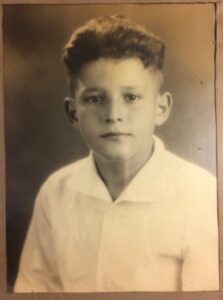
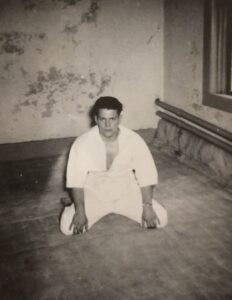
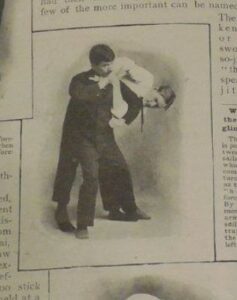
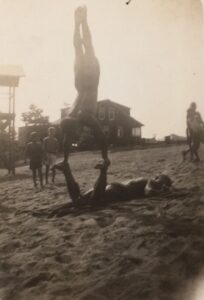
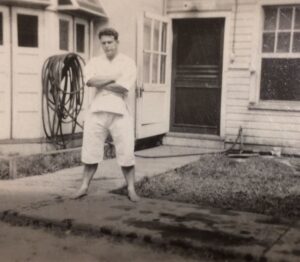
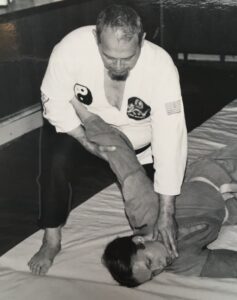
Chris Leblanc
Fascinating. Such a storied time in the overseas transmission of jiujitsu. Funny that today some of the people actually policing the streets are trying to bring jiujitsu back, when cops were already being trained in it back then.